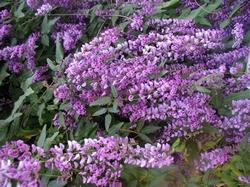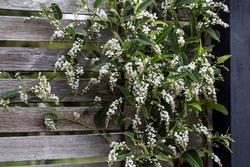Hardenbergia: Big Winter Bloom, Little Effort

Hardenbergia comptoniana was named for Countess von Hardenberg, sister of a 19th century patron of botany. Photo: PlantMaster
Hardenbergia is a winter delight, blanketing fences and arbors with an abundance of purple flowers January to spring. This evergreen vine is native to Australia, with flowers shaped like sweet pea blooms and leaves that are dark green, narrow, and two to four inches long. It tends to be a moderate grower that, fortunately, does not take over the garden like some vines. Hardenbergia is a twining vine that needs support. Although purple-blooming Hardenbergia is most common, there are also pink and white vining species, as well as cultivars that are small shrubs, including H. violacea 'Mini Haha.'
> See photos and growing tips for Hardenbergia.

Hardenbergia violacea 'White Icicle' blooms are a pleasant addition to the winter garden.
Plant
Hardenbergia in sun or in light shade where summers are hot. It appreciates light soil but can tolerate clay if it drains well. Once established, it needs little water.
Hardenbergia withstands tough conditions such as wind and heat. It is hardy to around 23°F and will probably experience severe damage below 20°F. To keep it tidy and avoid an overly woody plant, prune up to one-third of the plant after bloom. For a thicker vine, prune only where it twines around itself. Although it is not considered an aggressive vine, it will scramble across the ground and wrap itself around other plants.
Hardenbergia goes by many common names, including coral pea, lilac vine, wild or false sarsaparilla and wild wisteria. It belongs to the Papilionaceae family. This family name is derived from the Latin papilio (butterfly), which reflects the shape of the pea and bean flowers.


